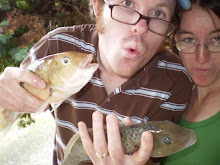There was no time for rest for these weary travellers. The next morning we set off from St Andrews again, this time heading further west to Kakamega Forest – the largest remaining rainforest in Kenya. As we approached Kericho, we entered into tea country. Field after field was covered in a well-manicured sea of green. Hundreds of workers were out picking tea leaves into their woven baskets. Surprisingly beautiful. We continued west to Kisumu and Lake Victoria. As we climbed our way up from Kisumu, we pulled over to confirm we were on the right track and stalled the vehicle. It was here on these steep slopes we experienced the beast’s unwillingness to restart after it had been driven for any length of time. After my attempted reverse hill-start almost got us into further trouble, we had no choice but to wait for the car to cool down.
 |
| Ohhh, I'd luve a bush of tea |
We wondered across the road to a store outside an orphanage and cooled ourselves down with a larger Bitter Lemon. Anna had a good opportunity to try her Swahili on the locals as we waited. Finally after about 20 minutes the engine kicked in and we were on the road again.
As well as visiting the forest, we hoped to visit Joanne Moyer. She had been conducting research about how people learn in faith-based development and conservation organisations. She began at A Rocha for three months before going to Kaimosi to research the Rural Service Programme of the East Africa that is run by a group of Quakers. We had become friends and we had missed hassling her since she had left. As usual, time was running out and the sun setting so we had to cut our visit short to make to the forest in time. We, however, missed the turnoff (because the sign faced the other way) and drove an extra 20 km in the wrong direction. It was almost dark, we weren’t actually sure where the camp grounds were and didn’t like the idea of setting up camp in the pitch black, so we headed back to Joanne who was most happy to have us stay. The next morning we were meant to be away by 6:30 AM to meet up with a guide who would take us around the forest. We slept in! We packed up supper fast, ate chapattis with bananas for breakfast on the road and ended up only 30 minutes late. Our guide, Job, took us for a 4 hour walk through the forest showing us four species of monkey, loads of birds, butterflies and plants. The definite highlights were super tall trees and Black-and-white-casqued Hornbill. This huge bird taps on branches causing chameleons to change colour and thus reveal themselves. Very clever! Joanne had left her head-light at a guesthouse a few weeks earlier so we decided to be kind and drop it off to her on the way back. A good thing too, as in our rush to get away that morning we had left behind our pillows!
 |
| That bill means business |
 |
| The ants go marching one by one million. Safari ants pack quite a punch if you mess with their march |
We farewelled Joanne for the last time and headed home determined to arrive before dark. On the long drive back we discovered another quirk with the beast. If you hold the clutch in too long, the gear box seems to ‘fall out’ and the engine turns off for a few seconds before the momentum kick-starts it again followed with the smell of burning oil or rubber. Was a bit scary the first few times but I soon learned how to avoid it. We also decided to pick a couple hitchhikers on the way back. Before we knew it, four people had crammed in the back. They were grateful to get a lift to the next town in their search for work.
And what would you know; we arrived back in Turi 30 minutes before dark. We had travelled over 1000 kms in the past 5 days, all made possible by the generosity of the Johnsons!











